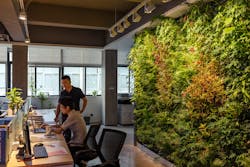The increasing use of green walls in the urban environment is a significant 21st-century design trend. Also known as living walls, bio-walls or vertical gardens, and a feature of both interior and exterior spaces, essentially they are vertical surfaces which support living vegetation.
ERCO recently issued a whitepaper which provides guidance and advice on lighting green walls, a form of illumination which has very specialized requirements. Based on the latest findings and research, "The perfect lighting for green walls" outlines all the key considerations involved and responds to the most frequently asked questions.
Widely featured in the interiors of workspaces, lobbies, shops and restaurants, green walls are visually pleasing and appeal to our innate love of nature. However, their role is wider and more profound.
The notion of biophilia is increasingly recognized as an important design tool. Introducing natural elements to essentially artificial environments has been shown to lift people's mood, increase productivity and reduce stress. In addition to the visual and biophilic benefits, with supporting technology they are also green in an environmental sense, contributing to natural air purification, cooling and humidification. In addition, they act as noise absorbers.
Crucial for Plant Health
For example, plants especially need the orange and red range of the light spectrum, plus blue light, to carry out photosynthesis (the process by which green plants use sunlight to synthesize nutrients from carbon dioxide and water). However, only a source that also includes the green range of the spectrum and has good color rendering is essential for a natural and attractive impression of green walls in architectural surroundings.
It is also crucial to provide uniform light levels across the vertical surface to create the best conditions for the even, steady growth of plants. While downlights and spotlights might conventionally be used in these spaces, they will not provide the correct distribution. Wallwash fittings, however, are ideal for this application.
The whitepaper provides a comprehensive, detailed guide to all these aspects of lighting green walls, including visual examples and practical tips. It also examines areas such as calculating the location of luminaires, the optimum length of exposure to light, and more technical considerations such as the measurement of photosynthetic photon flux (PPF), the quantity of photons emitted by a light source that are relevant for photosynthesis and chlorophyll production.
Suitable luminaire types are examined, and a glossary of relevant technical terms is provided, as well as a references list and a useful checklist for specifiers.
A copy of the whitepaper is available for download here.

